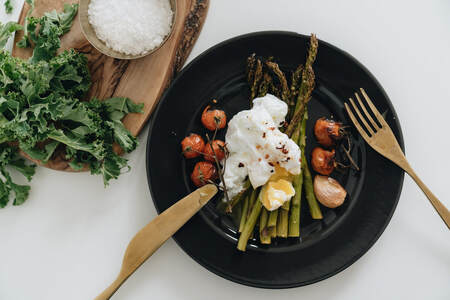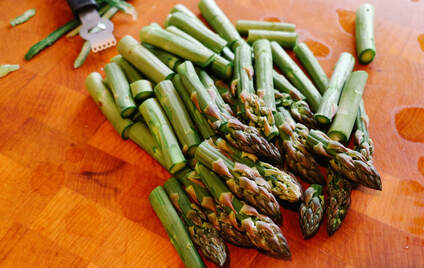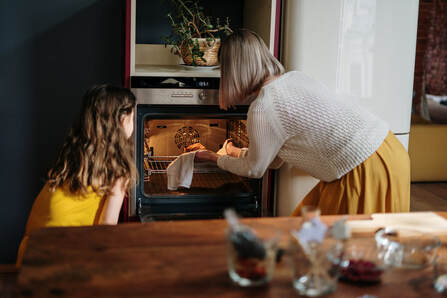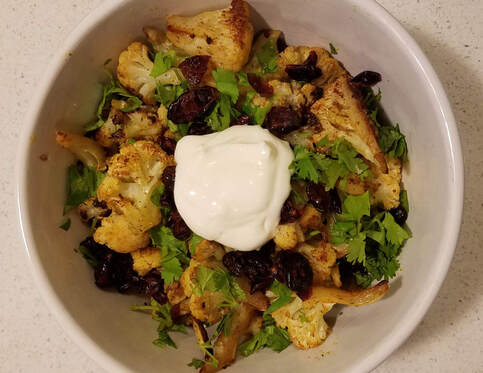Roasted vegetables you say? Groundbreaking.
I know I know. It looks and sounds like a simple method, but there are still a few tips that I like to follow to make sure the process is as easy and quick as possible and minimize cleanup. I mean, who wouldn't want that?
Let’s take a look
Roasting at its core is cooking food in a hot oven. What makes it different from baking has to do with what temperature you’re cooking at. Baking occurs at a more moderate heat - usually between 325 and 375 degrees farenheit. Roasting on the other hand happens above 400 degrees. This does two things to the food - it creates more browning more quickly than cooking at lower temperatures, and also develops more intense, toasty flavors as a result of all the browning and chemical reactions happening. Roasting also gets you the added benefit of those crispy edges that I will fight people at dinner parties for, but I digress.
Preparing Your Veg:
If you’re roasting, it’s all about the surface-area-to-inside ratio of the pieces of food (really technical term there I know). High heat cooks food fast, so generally, I like to cut up my food to be roughly bite-sized (yes, they can be big bites) before roasting. This makes sure there is not too much in the centers of the veggies to take time to cook thoroughly before the outsides brown too much.
Harder, denser veggies like cauliflower and sweet potato in general should be cut smaller since they will naturally take longer to cook. Softer ones like zucchini and onion can be left larger since they will cook faster. If you’re cooking a mix of vegetables together on one pan, make sure to cut them accordingly so they will cook and be done together,
Finally, to make sure the heat effectively gets to the vegetables, you also want to make sure you coat your veggies in some oil before going in the oven, which brings me to….
Oiling and Seasoning:
The oil you choose when roasting is also important. Since you will be cooking with heat in excess of 400 degrees, you want a neutral flavored oil with a high smoke point so you don’t end up turning your kitchen into a smoky horror movie set. I recommend vegetable oil or canola oil since both are readily available, versatile, neutral flavored, and have high smoke points.
Seasoning is also very important when roasting, and I like to season at the same time as I coat everything in oil. When it comes to roasting, I recommend keeping things relatively simple - salt, pepper, and a light hand when it comes to spices and herbs.
I say a light hand with herbs and spices because unlike salt, which will basically never burn because it’s a rock, herbs and spices can easily burn in a hot oven. So if I roast, I like to add just a enough to be able to know it’s there and add more after roasting if needed.
So what is the best way to oil and season? I like to do things in a very large bowl - for 4-6 servings, I add all my cut and prepared veggies, add about 2-3 tablespoons of oil, a teaspoon of kosher salt (and any spices), and toss with my hands until everything is lightly and evenly coated.
Into the Oven:
Before putting food into the oven, you want to make sure everything is in one layer on your baking sheets - and yes, that means you may need to use multiple pans or a mix of your sheet pans and large cake pans to do so. You also want to make sure it that if your vegetables have a natural “flat” side, that those are facing down and in contact with the pan.
Why the extra effort? Both these steps help make sure there is as much contact between the food and hot pan as possible to promote browning and thus, flavor.
Once in the oven, you want to check on your cooking veg every 10 minutes or so to see how things are progressing. Depending on the size of the vegetables, how much food is being roasted at once, moisture content, and more, total roasting time can vary. My rule of thumb is to check every 10 minutes for browning and progress. At least once during cooking I like to flip the vegetables when the side in contact with the pan is browned. That point forward, I check every 5 minutes until the second side is browned to my liking. Side two will be faster to cook than side 1, so don’t ignore it too long.
Serving:
Alright, we’re almost at the finish line - how do you serve your newly roasted veggies? Well, the short answer is however you want, but I do recommend trying out some of the additions below if you’re feeling ~adventurous~
- Add a creamy sauce - Sour cream, greek yogurt, garlic aioli - something creamy and tangy is a great way to dress up roasted vegetables, especially crispy roasted vegetables like brussels sprouts
- Dried fruit and nuts - especially for non-crispy roasted vegetables like onions, zucchini, cauliflower - these add contrasting flavors and textures that make eating it a little more exciting. Chopped almonds and dried cranberry and hazelnut and dried apricots are two great combos, but play around.
- Fresh herbs - You’ve transformed your veg, now bring some brightness and green back with fresh herbs. I recommend leafy herbs like cilantro and parsley and feel free to not finely chop everything - just tear it up by hand, call it “rustic”, and you’re good.
A Recipe: Curry Roasted Cauliflower with Cilantro, Cranberry, and Yogurt
Serves: 3-4
- 1 head cauliflower
- 1 tsp curry power
- 1/2 tsp garam masala
- 1/2 tsp chili powder
- 1 tsp salt
- 2 tablespoons vegetable or canola oil
To Serve:
- Plain Greek yogurt, dried cranberries, and chopped cilantro
Directions:
- Pre heat your oven to 425 degrees
- Remove the core of the cauliflower and cut into large bite-sized pieces (See how here)
- In a large bowl, toss the cauliflower, oil, curry powder, garam masala, chili powder, and salt until well coated - pour out onto 1 large baking sheet and make sure everything is in one layer
- Roast cauliflower in the oven for 10-15 minutes and then check for browning - if still pale on the side facing the pan, give it 5 more minutes until browned
- Give cauliflower a toss on the pan and flip so the other side of the cauliflower can also have a chance to brown. Roast for an additional 5-10 minutes until browned and tender but still crisp
- Remove the pan from the oven and cool cauliflower for at least 5 minutes
- Transfer to a large bowl or platter and top generously with fresh cilantro, dried cranberries, and a large dollop of plain greek yogurt or sour cream
Stay safe and keep on cooking y'all




